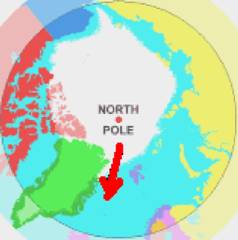- Screen Reader Access
- Skip to : main content / navigation
- Text Size
- Home
- Sitemap
- Contact us
- हिंदी
|
Arctic sea ice is shrinking, both in extent and thickness. Over the last 30 years, satellite data document a loss of summer Arctic sea ice area of −13.5 % per decade. The loss of sea ice area has increased with time, since it was around −3.0 % per decade up to the 1990s. In addition to the anthropogenic contribution to the sea ice loss, there are also natural factors contributing to this loss. The contributions from each are still under debate.
In a new study focus on one of these factors, namely the ice export through FRAM STRAIT – the
large gateway between Greenland and Svalbard. In recent years, this ice export has been about 200 thousand km2 which is higher than in any decade between the late 1950s and up to today. This increase in the export contributes to the Arctic sea ice loss, as shown in a recent study (Smedsrud et al., 2008). |
 |
The climate models also show that the Arctic is losing sea ice, but it is not known how they represent the ice export in the Fram Strait. This study examines the ice export in 6 current climate models that provides 24 different simulations. Perhaps surprisingly, most of these coarse resolution models manage to reproduce a realistic seasonal cycle of the ice export, with more ice floating through the strait during winter than summer. Not all simulations show an increase in the ice export from the late 1950s and up to today. Some simulations actually show a decrease in the ice export.
Because the simulations do not show similar behaviour, it is interpreted that changes in the ice export is not governed by external forcing, such as changes in the CO2 concentration or changes in the incoming sunlight. The ice export is rather controlled by internal climate variability within each model, for instance, variability in the wind pattern over the Arctic. According to the model with the largest number of simulations (10), the researchers (Langehaug et al., 2013) found that a thinning of the Arctic sea ice is associated with an increase in the ice export, whereas a decrease in the ice export is related to a smaller thinning.
Journal Reference: H.R. Langehaug, F. Geyer, L.H. Smedsrud, Y. Gao. Arctic sea ice decline and ice export in the CMIP5 historical simulations. Ocean Modelling, 2013, DOI: 10.1016/j.ocemod.2012.12.006.
L.H. Smedsrud, A. Sirevaag, K. Kloster, A. Sorteberg, S. Sandven. Recent wind driven high sea ice area export in the Fram Strait contributes to Arctic sea ice decline. The Cryosphere, 2011, 5, pp. 821–829.